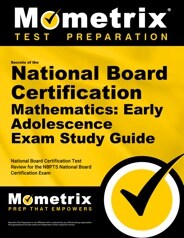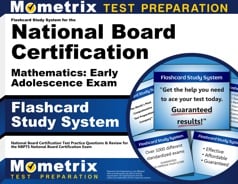The National Board for Professional Teaching Standards (NBPTS) certifies teachers who adhere to set standards that ensure a positive impact on their students and themselves as members of the teaching profession. They offer several certifications based on your chosen subject and age group of focus.
Here, we will be focusing on the certification exam for Mathematics for Early Adolescents (age 11-15).
Exam Eligibility
The basic eligibility guidelines to apply for the Mathematics for Early Adolescence certification are:
- A bachelor’s degree
- A valid state teaching license
- Three years of classroom experience
Part-time and long-term substitution teaching counts towards the three-year employment requirement as long as you also hold a valid state teaching license and the time computation follows those outlined in the eligibility guidelines.
As of September 19, 2022, NBPTS allows those who haven’t met the three-year experience requirement to begin the application process as long as they fulfill this requirement by the end of their application process.
About the Exam
While all NBPTS assessments are completely voluntary, there are also benefits to completing and passing them. As a teacher, you will gain relevant professional development that will directly impact your students and your teaching practice. These rigorous assessments were also created by teachers for teachers, so you are secure that you will be tested on skills that are appropriate for your profession.
Through the Early Adolescence Mathematics assessment, you will be expected to meet the National Board’s Five Core Propositions and Standards. They outline what accomplished teachers know and do to impart a positive impact on their students and their learning process.
The Five Core Propositions include:
- Proposition 1: Teachers are committed to students and their learning
- Proposition 2: Teachers know the subjects they teach and how to teach those subjects to students
- Proposition 3: Teachers are responsible for managing and monitoring student’s learning
- Proposition 4: Teachers think systematically about their practice and learn from experience
- Proposition 5: Teachers are members of learning communities
Based on these propositions, the National Board has set specific standards for each subject area. For Mathematics, the standards are:
- Commitment to Mathematics Learning of All Students
- Knowledge of Mathematics
- Knowledge of Students
- Knowledge of the Practice of Teaching
- Learning Environment
- Ways of Thinking Mathematically
- Assessment
- Reflection and Growth
- Families and Communities
- Professional Community
Check Out Mometrix's National Board Certification Study Guide
Get practice questions, video tutorials, and detailed study lessons
Get Your Study Guide
Certification Components
The Mathematics for Early Adolescence certification consists of four components. Component 1 is the only test-taking component, which is in the form of a computer-based assessment. Components 2-4 create your portfolio, which you submit online.
All four components are required for certification.
- Component 1: Content Knowledge. This is the computer-based assessment that measures your knowledge of the teaching content area and its appropriate teaching practices.
- Component 2: Differentiation in Instruction. This portfolio entry allows you to showcase your abilities to evaluate how your students learn with their strengths and weaknesses, and how you can plan and implement these teaching strategies while being analytical and open to modification of your techniques.
- Component 3: Teaching Practice and Learning Environment. This portfolio entry lets you detail your planning process for teaching by providing direct evidence of your teaching techniques and abilities through a demonstration and your instructional materials, and your ability to reflect and analyze your teaching abilities.
- Component 4: Effective and Reflective Practitioner. This portfolio entry lets you highlight your abilities as an effective and reflective teacher by developing and applying your knowledge of your students.
The testing window for Component 1 ranges from the beginning of March to the middle of June. The submission window for your portfolio components goes from the beginning of April to the middle of May.
Exam Outline
Component 1: Content Knowledge
For this component, the assessment component, you must demonstrate your knowledge in creating developmentally appropriate content that can be applied and adapted across the full age range and ability level of the certification you are applying for.
This computer-based assessment consists of 45 selected-response questions and three constructed response exercises. You are given a total of 75 minutes to answer the selected-response portion and 30 minutes for each constructed response exercise, with a 10-minute break between both portions of the exam.
Selected-Response Questions
The selected-response questions cover the following content areas in the approximate percentages listed:
- Contexts for Mathematics (15%): Subjects in this category include the historical development of mathematical ideas, mathematical applications in fields related to mathematics, and precise communication of mathematical ideas.
- Problem-Solving and Number Sense (45%): Subjects in this category include algebraic functions, numbers and operations, and geometry.
- Modeling and Analysis (40%): Subjects in this category include trigonometry, calculus, data analysis and statistics, and discrete mathematics.
Constructed-Response Questions
The constructed-response questions assess the following areas per question:
In this exercise, you will be tested on your ability to use algebra and functions to model problem situations, employ algebraic techniques and procedures, and explain a given functional relationship. This exercise contains three prompts.
Exercise 2: Geometry
In this exercise, you will be asked to perform the transformations of dilation, reflection, rotation, and translation on a two-dimensional figure, and you must explain how the two figures are similar and/or congruent. You will also need to explain the volume formula of a three-dimensional figure and how it relates to the volume of a figure with the same type of base. This exercise contains two prompts.
Exercise 3: Data Analysis and Statistics
In this exercise, you will be asked to provide various graphical representations and interpretations of a given set of data. This exercise contains one prompt.
Be sure to provide all your responses for the constructed response portion in the provided test booklet that is given to you on the day of the exam.
Component 2: Differentiation in Instruction
For this portfolio entry, you are required to:
- Choose two instructional activities and two student responses to each activity that demonstrate how you designed the learning experience for the students to understand a substantive idea in mathematics and how it enhances their ability to think and reason mathematically.
- Submit a written commentary that provides context for your instructional choices and describes, analyzes, and reflects on your teaching.
Component 3: Teaching Practice and Learning Environment
For this portfolio entry, you are required to:
- Provide a brief overview of the content of your overall submission.
- Submit two 10-15 minute videos of your teaching practice, showcasing different instructional units, content, and strategies in each.
- Submit information about the instructional context for each video.
- Describe your instructional planning for the lesson featured in each video and submit appropriate supporting materials.
- Submit a commentary for each video that includes analysis and reflection on your teaching practice; that communicates your pedagogical decision-making before, during, and after the lesson shown in the video; and that focuses on your impact on student learning.
Component 4: Effective and Reflective Practitioner
For this portfolio entry, you are required to:
- Provide a profile for one entire class from the current school year.
- Collect relevant information about the students and provide evidence of collection.
- Use accumulated knowledge about students from the current year to analyze the effectiveness of your practice and to initiate or contribute to collaborative efforts in the school, district, community, or other learning communities designed to support students’ learning and growth.
- Reflect on your practice of gathering and using information about students and how you can best contribute to positive changes for students and your practice in the future.
Check Out Mometrix's National Board Certification Flashcards
Get complex subjects broken down into easily understandable concepts
Get Your Flashcards
Exam Registration
The NBPTS certification process can take place between one and five years. All components must be submitted within three years, and you are only allowed an additional two years for retakes only.
Register for an account using the National Board Candidate Management System (NBCMS) to begin the certification process and purchase components. There is a $75 registration fee for every cycle year that must be paid before you can purchase a component.
Once you have registered, make sure to take note of the deadlines for registration, taking an exam, and submitting the requirements and portfolios. These deadlines vary yearly but generally, registration and component selection is open from July to February of the following year.
Once registration for Component 1 is done, you will receive an email notification to schedule an exam appointment on the affiliated Pearson VUE website. The website also provides a tutorial experience to help prepare yourself better for the exam.
Fees
The fee to take each component costs $475. This makes the total cost of the certification process $1,900. You can pay for the full fee in one go or spread out the payment over the three years of application. Keep in mind that you need to pay the additional $75 registration fee to maintain your online account.
NBPTS offers a payment plan that divides the cost of your certification over six equal payments, and financial aid may be available from your state or district.
Test Day
Be sure to arrive 30 minutes before the start of the assessment. If you arrive more than 30 minutes after your scheduled exam time has started, you will not be allowed to enter the test venue.
To be admitted into the test venue, you must bring a valid government-issued identification card with your photo, signature, and a name that matches the name you used when applying for the exam.
Before the exam, you will be required to sign a Non-Disclosure Agreement to maintain the integrity of the exam. You will then be provided a test booklet and pencils for the constructed response portion. An online scientific calculator on your computer will be available during the exam.
How the Exam is Scored
For Component 1, each selected-response question you answer correctly is given one point. Your total score will be converted to a rubric score scale from 0 to 4.25. For the constructed-response questions as well as Components 2, 3, and 4, your score will be assessed using a 12-point rubric score scale that ranges from 0.75 to 4.25.
To achieve certification, you must achieve a score of 2.75 on all components, signifying clear evidence of accomplished teaching practice. The absolute minimum average scores you can achieve for all components are 1.75, with a total weighted scaled score of at least 110. However, these latter scores do not guarantee an NBPTS certification compared to achieving the earlier score of 2.75.
If you pass all components, you are now eligible for board certification. Make sure to keep in touch with the NBPTS and update any contact information on your NBPTS account so they can communicate important information with you.
Retaking the Exam
If you fail to achieve a passing score on any of the components, you are allowed to retake each of them up to two times. The highest numeric score received on each component will be used for the total score calculation.
Preparing for the Exam
National Board Certification adds weight to your experience, setting you apart from other educators who have not received certification.
Our National Board Certification: Mathematics (Early Adolescence) study guide and flashcards help direct your studying, so the time you spend is effective, resulting in a higher score!
FAQs
Q
What is the National Board Certification?
A
The National Board Certification is an advanced professional certification for PreK-12 educators, provided by the National Board for Professional Teaching Standards (NBPTS). The certification identifies teaching expertise through assessments that are performance-based and peer-reviewed.
Q
Can I retake the National Board Certification exam?
A
You can retake the Mathematics (Early Adolescence) exam up to two times during a five-year window.
Q
What is a passing score on the National Board Certification?
A
A passing score on the assessment component of the Mathematics (Early Adolescence) Exam is 2.75. A passing score for each of the portfolio components is also 2.75.
Q
How long is the National Board Certification exam?
A
The assessment component of the Mathematics (Early Adolescence) exam lasts for 1 hour and 45 minutes, with a 10-minute break between sections.
Q
How much does the National Board Certification exam cost?
A
The fee for each component of the Mathematics (Early Adolescence) exam is $475, making the total cost of certification $1,900 (not including the $75.00 registration fee).
Q
When will I receive my test scores?
A
You will receive your test scores around the second week in December.

